
[ Thimphu Festival Tour | Thangbi Mani Festival Tour | Jambay Lhakhang Drup Tsechu Festival Tour | Black Crane Festival Phobjikha Tour | Punakha Domchey Festival Eight Nights Tour | Punakha Domchey Festival Ten Nights Tour | Chorten Kora Tsechu (arrive Paro, Depart Paro) | Chorten Kora Tsechu (arrive Paro, exit India) | Chorten Kora Tsechu (arrive India, exit Paro) | Gom Kora Tsechu (enter Paro, exit Paro) | Gom Kora Tsechu (enter Paro, exit India) | Gom Kora Tsechu (enter India, exit Paro) | Paro Tsechu Festival Tour | Paro Tsechu Festival 7 Dzongkhags Tour | Paro Tsechu Festival Tour with Druk Path Trek | Ura Yakchoe Festival Tour ]
Ura Yakchoe Festival Tour
- 10 Nights 11 Days
- Bumthang, Central Bhutan
Dzongkhags Covered: Paro, Thimphu, Punakha, Trongsa, Bumthang, WangdueDuration: 10 Nights 11
Days.
Trip Grade: Easy.
Itinerary Outline:
Day 1: Arrival in Paro. Head to Thimphu
Day 2: Thimphu – Punakha
Day 3: Punakha – Trongsa
Day 4: Bumthang
Day 5: Attend Ura Yakchoe Festival
Day 6: Attend Ura Yakchoe Festival
Day 6: Bumthang - Gangtey
Day 7: Gangtey to Paro
Day 8: Paro - Haa via Chelela Pass
Day 9: Paro
Day 10: Depart Paro
Ura Yakchoe Trip Overview:
Ura Yakchoe - Ura is a beautiful village in Bumthang set amidst a pristine highland meadow across the Thumshingla Pass. The village has retained its traditional character and holds its own festival that offers an insight into lives of the rural Bhutanese. The legend behind the Festival of Ura begins with an old woman who, while sitting outside her house, gets a mysterious visitor- a lama who asks her for a glass of water. When she goes inside her home and returns with a glass of water, the lama has vanished leaving behind a sack. Out of curiousity, she opens the sack to find a Statue (a relic). That was then. Now, ever since, this relic has been passed on from generation to generation, which is now owned by the descendants of the woman. This festival is organised annually and the relic is displayed to the public. You will see locals dressed in their finest clothes who have walked from miles around to attend the festivities. They come and watch mask dances, pray, and feast. While the underlying purpose of the festival is spiritual, dances are more often like plays, stories where good triumphs over evil and historical events especially encompassing the life Guru Rinpoche.
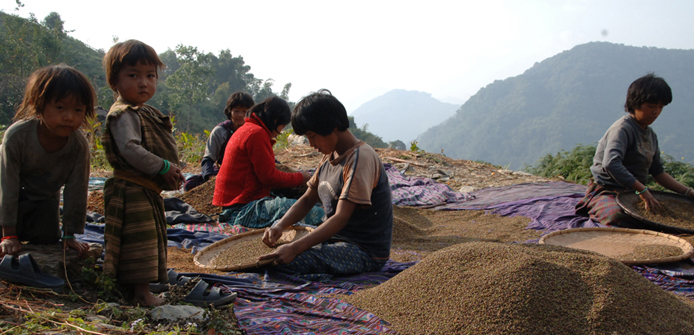
Ladies cleaning buckwheat (the staple crop of Bumthang) after
harvesting.
Detailed Itinerary:
Day 1 - Arrival in Paro. Head to Thimphu
Elevation 2,280 m.
Welcome to Bhutan, the Land of the Thunder Dragon. Touching down at Paro
International Airport, you will be greeted by your guide upon exiting
the arrival hall. Today, we will take it easy to acclimatise to the altitude.
An hour's drive to Thimphu, check in to the hotel and let's have your
first taste of Bhutanese cuisine and some light sightseeing, like the
vegetable market in Thimphu, if possible. Known as the Centenary Farmers’
Market - mostly on the weekends a majority of the Thimphu population congregate
on the banks of the river where the market is held. Here, villagers from
the valley and other nearby places come to sell their agriculture products
to the denizens of the Capital.
Day 2 - Thimphu – Punakha
Elevation 1,300 m
We will then head on to Punakha, the ancient capital of Bhutan in the
morning. The road brings visitors through scented pine and cedar forests,
festooned with hanging lichen. We also cross the Dochula Pass ('La' means
'mountain pass') - at 3,050 m with the 108 chortens built in the 1990s
by the present Queen Mother of Bhutan, Ashi Dorji Wangmo Wangchuck, to
commemorate Bhutan’s victory over the Indian militants (the mlitants
were based in Bhutan for a long time to attack India) and to liberate
the souls of the souls lost. The Punakha River is one of the biggest rivers
in Bhutan. During spring and winter, the colour of the river turns jade
and is beautiful. We also visit the Chimi Lhakhang, a 20 minutes walk
across terraced fields through the village of Sopsokha from the roadside
to a small temple located on a hillock in the centre of the valley below
Metshina. Ngawang Chogyel built the temple in 15th century after the 'Divine
Madman' Drukpa Kuenlay built a small chorten at this place. Women who
are having difficulty in getting a child come here from all over, to this
'Fertility Temple'.
Day 3 - Punakha – Trongsa
Elevation 1,300 m
Wangduephodrang - One of the major towns and district capital of Western
Bhutan. We will pause to view the ruins of the Wangduephodrang Dzong as
sadly, the Dzong was razed by fire in 2012. Funds to renovate have been
raised from both Bhutanese and visitors. Dramatically perched on the spur
of a hill, built in 1638, this Dzong overlooked the confluence of the
Tsang Chhu and Dang Chhu rivers. This is the last town before Central
Bhutan. The district is famous for its fine bamboo work and its slate
and stone carvings.
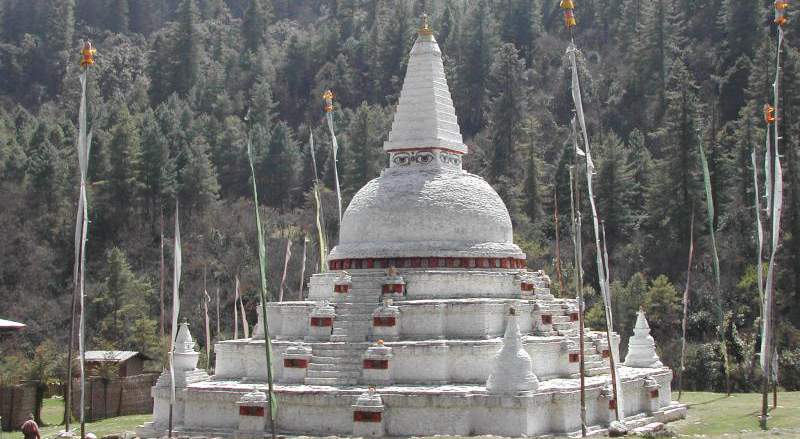
On route to Trongsa we cross the Chendebji Chorten - also called
Chorten Charo Kasho It is in the Nepalese style like Stupa of Swayambhunath
or Bodhnath built in the 19th century by a Tibetan Lama. It was built
on the remains of an evil spirit that was tormenting the people of that
region. The Eyes are the striking feature.
Day 4 – Bumthang
Elevation 1,300 m
The Ura Yakchoe Festival will culminate with a rare display of a giant
silk applique thangkha (painting) depicting Guru Padmasambhava (Guru Rinpoche)
or some other important Buddhist deity this morning. In the morning, we
will hike to the Tamshing Goemba, built in 1501 by the Buddhist saint
Pema Lingpa. We will also visit Kurjey Lhakhang, one of the most sacred
monasteries in Bhutan. Built by Guru Rinpoche in 1652, it houses a rock
with his body imprint. Legend has it that Guru Rinpoche manifested as
a Garuda (a large mythical bird/eagle-like creature) to defeat the demon
Shelging Karpo who had taken the form of a White Lion. We will also visit
Jambay Lhakhang, built in 659 by the Tibetan King Sontsen Gampo to pin
down a demoness who was obstructing the spread of Buddhism. Come October,
the Jambay Lhakhang Drup is
one of the most colourful festivals in Bhutan. In the afternoon, we will
hike up to Thangbi Valley, crossing a suspension bridge to visit the Thangbi
Lhakhang built in the 14th century via an unpaved road.
Day 5 - Day Trip to Ura Valley and Attend Ura Yakchoe Festival
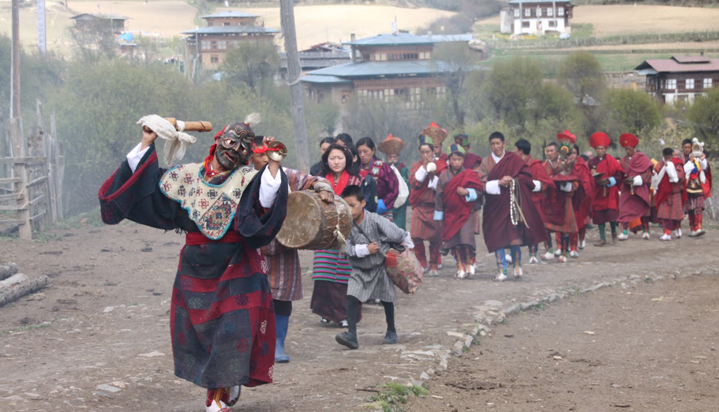
Ura Valley – One of the most tranquil and beautiful valley, Ura is a must visit valley in Bumthang. While in Ura visit the Ura Monastery and simply enjoy the meadows and the beautiful landscapes and the buckwheat and barley fields.
Ura Yakchoe Festival (see above): As the legend goes, a long time ago, an old woman was visited by a lama. This Lama seemed very mysterious and all he asked from the old lady was a glass of water. The old lady being kind as she was went to fetch water and when she returned the Lama was nowhere to be found. But there was a sack outside her doorsteps. She opened the sack out of curiosity, found a statue in the sack. The statue was no ordinary statue, for it was a relic. From that day onwards, the relic has been passed down from one generation to the other and today the same relic is displayed to the public during the festival. Overnight at Bumthang.
Day 6 - Attend Ura Yakchoe Festival
Continue celebrating Ura Yakchoe Festival. Overnight at Bumthang.
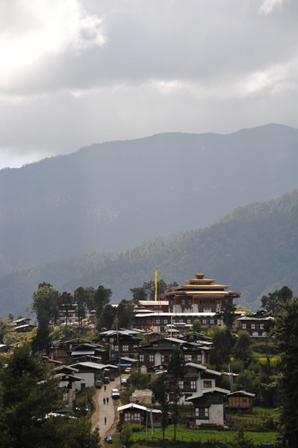 Day
7- Bumthang - Gangtey
Day
7- Bumthang - Gangtey
The valley of Phobjikha is well known as the winter home of the Black-Necked Cranes (Grus Nigricollis). Bhutan is home to around six hundred Black-Necked Cranes with Phobjikha being one of the popular places that the birds migrate to in the winter months from the Tibetan plateau. The elegant and shy birds can be observed from early November to the end of March. Overlooking the Phobjikha valley is the Gangtey Goemba (left). This is an old monastery that dates back to the 17th century. Today we will do some short hikes around the valley of Phobjikha.
Day 8 - Gangtey to Paro
Elevation 2,320m
In the morning, walk along the valley. Visit Khewang Lhakhang - a late
15th century old temple built by Truelku Penjor Gyaltshen, the reincarnation
of Kuenkhen Longchen Rabjampa. In the afternoon, we start our drive to
Paro. Paro Valley is home to many of Bhutan’s old monasteries and
temples. The country’s only International Airport is in Paro. The
valley is also home to Mount Jhomolhari (7,300 metres) situated at the
northern end of the valley whose glacier water forms the River Pachhu
flowing through the valley.
Day 9 - Paro - Haa via Chelela Pass
Elevation 2,280 m
Drive to Haa through the Chelela Pass (3,988 m). From the pass you can
see Paro valley on one side and Haa valley on the other. You can also
have a picnic at Chelela if you like. In Haa, some sightseeing and then
go on to Katsho village and visit the Katsho Lhakhang. The valley of Haa
was only opened to tourists in 2002 and so Haa is the least visited valley
in Bhutan due to the lack of tourist infrastructure. This has helped in
keeping Haa the way it has always been, with Bhutanese families living
their traditional and simple life. There are no tourist standard hotels
in Haa valley so we return back to Paro for the night.
Day 10 - Paro
Elevation 2,280 m
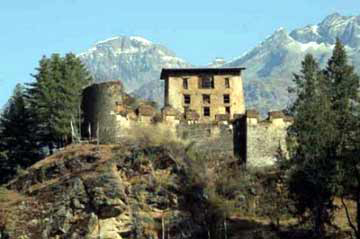 A
morning drive, north of Paro valley brings us to the ruins of Drugyal
Dzong (right). Built in 1647 by the great Shabdrung Ngawang Namgyal,
father and unifier of medieval Bhutan, the Dzong was destroyed by an accidental
fire and left in ruins as an evocative reminder of the great victories
it was built to commemorate. Explore the ramparts and relive the memories
of a glorious past. Beyond Satsam Chorten, we hike up to the Taktsang
Monastery (Tiger’s Nest). The 1.5 hour hike to the cafeteria is
also a vantage view whereby you can enjoy the stunning view of the monastery.
Prayer flags adorn the cliffs and this is also where Guru Padmasambhava
(Guru Rinpoche) landed on the back of a tigress in the 8th century. After
a sumptuous local lunch, we will retrace our steps to visit Kyichu Lhakhang,
one of the oldest temples in Bhutan. Overnight in Paro.
A
morning drive, north of Paro valley brings us to the ruins of Drugyal
Dzong (right). Built in 1647 by the great Shabdrung Ngawang Namgyal,
father and unifier of medieval Bhutan, the Dzong was destroyed by an accidental
fire and left in ruins as an evocative reminder of the great victories
it was built to commemorate. Explore the ramparts and relive the memories
of a glorious past. Beyond Satsam Chorten, we hike up to the Taktsang
Monastery (Tiger’s Nest). The 1.5 hour hike to the cafeteria is
also a vantage view whereby you can enjoy the stunning view of the monastery.
Prayer flags adorn the cliffs and this is also where Guru Padmasambhava
(Guru Rinpoche) landed on the back of a tigress in the 8th century. After
a sumptuous local lunch, we will retrace our steps to visit Kyichu Lhakhang,
one of the oldest temples in Bhutan. Overnight in Paro.
Day 11 - Depart Paro
After breakfast, it is off to Paro airport and we bid you farewell from the Kingdom of Bhutan.
| |
BACK TO FESTIVAL TOURS MAIN PAGE |
